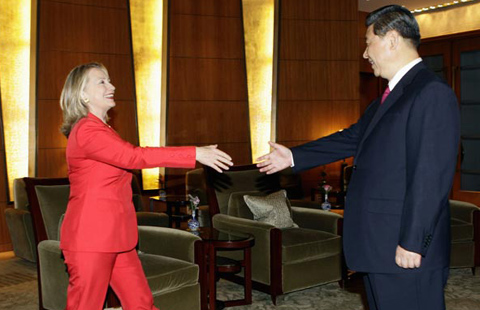
II. New Tibet Follows a Sound Path of Development
Tibet has undergone historic changes after the founding of the People's Republic of China in 1949. The peaceful liberation of Tibet in 1951 made it possible to expel the forces of imperialism from Tibet, and the democratic reform in 1959 brought to an end the feudal theocratic serfdom that had endured, and exerted both religious and political power, for hundreds of years. In 1965, the Tibet Autonomous Region was established, and the socialist system has since prevailed in Tibet. Following the launch of reform and opening up in 1978, the drive for modernization has brought extensive benefits to Tibet as much as to any other part of the country. Especially in the 21st century, Tibet has achieved even faster growth and further progress towards building a moderately prosperous society in an all-round way. Through more than 60 years of development, the people of Tibet have found a path of development that is both characteristically Chinese and suited to the actual prevailing conditions in Tibet. Thus, a new Tibet that is a blend of both the traditional and the modern has appeared.
- The development path of new Tibet safeguards the unity of the Chinese nation.
Tibet faced two different possible outcomes when the imperialists invaded the plateau in the modern era: unity with or separation from the Chinese nation. British colonialists invaded Tibet twice - in 1888 and 1904 - and forced the Qing court, which ruled China from 1644 to 1911, to sign a couple of unequal treaties that accorded Britain with many privileges in Tibet. When the Qing court was overthrown in 1911, the British began fostering separatist forces in Tibet, trying to engineer "Tibetan independence." No sooner had the People's Republic of China been founded in 1949 than separatists from the upper classes of Tibet were hastening to hatch plots for "Tibetan independence" with imperialist forces, attempting to separate Tibet from the motherland. Based on an assessment of Tibet's history and the prevailing conditions there, the Central People's Government of China decided to follow a principle of peaceful liberation for Tibet so as to safeguard national unity and territorial integrity. Patriots in Tibet, including the 10th Panchen Lama, also called on the central government to liberate and station Chinese People's Liberation Army troops in Tibet to ensure the unity of the country. The peaceful liberation of Tibet was finally achieved when the Agreement of the Central People's Government and the Local Government of Tibet on Measures for the Peaceful Liberation of Tibet (also known as the "17-Article Agreement") was signed on May 23, 1951. The 14th Dalai Lama sent a telegram to Mao Zedong, chairman of the Central People's Government, which read: "...The local government of Tibet as well as the ecclesiastical and secular people unanimously support this Agreement, and, under the leadership of Chairman Mao and the Central People's Government, will actively assist the PLA troops entering Tibet to consolidate national defense, ousting imperialist influences from Tibet and safeguarding the unification of the territory and the sovereignty of the motherland."
The peaceful liberation enabled Tibet to shake off the fetters of imperialism, confounded imperialist designs for an independent Tibet, and realized the unity of the Chinese nation in these new historical circumstances. It also addressed the issue between the Dalai Lama and Panchen Lama left over from history, leading to unity within Tibet. After the peaceful liberation, the Chinese government gradually revoked the privileges foreign countries had awarded themselves in Tibet. In 1954, the People's Republic of China and India signed the Agreement on Trade and Intercourse between the Tibet Region of China and India, abolishing the privileges India had inherited from the British invaders. In 1956, China signed with Nepal the Agreement on Maintaining Friendly Relations between the People's Republic of China and the Kingdom of Nepal and on Trade and Intercourse between the Tibet Region of China and Nepal, settling the issue between the local Tibet government and Nepal left over from history.
Over more than half a century since then, the Tibetan people have shared one mind, and in the face of every challenge have stood together with the people of other ethnic groups of the Chinese nation. Together, they have established a harmonious relationship featuring equality, solidarity and interdependence. The people of Tibet have stood firmly with the central government in spite of hardships endured and challenges faced in the struggle against separatist forces in order to safeguard national unity and solidarity, and also to share with the rest of the country the fruits and achievements of development in the course of rejuvenation of the Chinese nation.
In order to help Tibet develop rapidly and get rid of poverty and backwardness, the central government has fully exploited the institutional advantages of the socialist system to pool nationwide strengths to support the construction of Tibet, and a series of preferential policies have been adopted and great financial and material resources as well as manpower have been amassed to inject new impetus to its development. For the past six decades and more, the financial department of the central government has steadily increased transfer payments for Tibet. In the period from 1952 to 2013, the central government provided 544.6 billion yuan to Tibet in financial subsidies, accounting for 95 percent of Tibet's total public financial expenditure. Since 1980, five national symposiums have been called on work in Tibet, working out integrated blueprints for Tibet's development by proceeding from the perspective of the country's overall drive for modernization. Since the Third National Symposium on Work in Tibet in 1994, the central government has put into effect the policy of pairing-up support for Tibet where 60 central state organs, 18 provinces or municipalities directly under the central government, and 17 centrally managed state-owned enterprises have been paired up with and made to provide assistance to specific areas of Tibet. Over the last two decades, a total of 5,965 of China's best officials have been appointed to work in Tibet, 7,615 assistance projects have been carried out, and 26 billion yuan has been invested in Tibet and mainly directed at improving infrastructure and quality of life. All of this assistance has made an enormous contribution to Tibet's social and economic development. After the Fifth National Symposium on Work in Tibet in 2010, the central government determined that the 17 provincial and municipal governments involved in the paired-up support program should provide Tibet with 0.1 percent of their yearly fiscal revenues as aid funds, thus establishing a mechanism to ensure a steady growth in such aiding funds.- The development path of new Tibet ensures that the people are masters of their own fate.
The transformation of the old serf-owning Tibet into a new Tibet where the people are masters of their own fate was an essential precondition of Tibet's social development and also a fundamental aspiration of the people of all ethnic groups in Tibet. Within the framework of socialist democracy with Chinese characteristics, Tibet has embarked on a road of modern democracy, and all political rights of the people are fully respected and protected.
In Tibet there are Tibetans, Monbas, Lhobas, Naxi's, Huis, Han's and peoples of some other ethnic groups; they all enjoy the right to equally participate in the administration of state affairs. The system of people's congress, as a basic political system of China, serves as the main channel through which the people exercise their democratic rights. Now, the Tibet Autonomous Region has 21 deputies to the National People's Congress, of whom 12 are Tibetans, and even the Monba and Lhoba ethnic groups, despite their small populations, are each represented by one. The Chinese People's Political Consultative Conference (CPPCC) is unique to China's socialist democracy; it is an important platform for the Chinese people to exercise deliberative democracy. At present, Tibet has 29 members on the CPPCC National Committee, including 26 from the Tibetan and other ethnic minorities. Among the 34,244 deputies to the local people's congresses at all four administrative levels in Tibet, 31,901 are from the Tibetan, Monba, Lhoba, Naxi, Hui, Zhuang and other ethnic minorities, accounting for more than 93 percent. The 44-member standing committee of the tenth Tibet regional people's congress has 25 representatives from Tibetan and other ethnic minorities, who occupy eight of the 14 positions of chairpersons or vice-chairpersons. Community-level democracy is also subject to constant enhancement. More than 95 percent of Tibet's villages have established the system of villagers' representative meetings and elected villagers' self-governance organizations. All villages have made their affairs public and exercise democratic management, and more than 90 percent of them have set up billboards to guarantee the rights of the general public to be informed about, to participate in, to make decisions on, and to scrutinize local government. All of Tibet's 192 urban communities have also set up community residents' congresses and community committees, providing a solid organizational mechanism for the self-governance of local urban residents.
China's system of regional ethnic autonomy is based on the national conditions. Tibet is one of the five ethnic autonomous regions of China. According to the Constitution and the Law on Regional Ethnic Autonomy of the People's Republic of China, the Tibet Autonomous Region enjoys extensive autonomy in legislation, language, culture and education, and flexible application of relevant state laws as well as fiscal management and official appointments. Since their establishment in 1965, the regional people's congress and its standing committee have passed more than 290 local laws and regulations or resolutions and decisions of a legislative nature, and formulated measures for the flexible application of some state laws in Tibet in order to adapt them to local conditions.
Tibet created alternative regulations in 1981 and 2004, in which the legal age of marriage for both men and women was reduced by two years relative to the Marriage Law of the People's Republic of China, and polyandrous and polygynous relationships that had existed before the regulations took effect would be allowed to continue if no one involved proposed dissolution. Tibet also issued the Interim Measures for Family Planning in Tibet Autonomous Region (Trial). Han Chinese officials and workers and their families are authorized to have only one child per couple; as regards Tibetan, Naxi, Hui and Zhuang officials and workers, and their family members whose hukous (residency registration) are in relevant urban enterprises, are allowed to have two children per couple at reasonable intervals; farmers and herdsmen in farming and pastoral areas are not subject to any restrictions, likewise there are no restrictions on couples from the Monba, Lhoba, Sherpa and Deng ethnic groups.
In addition to the national holidays, Tibet has also established other public holidays, mostly traditional Tibetan festivals such as the Tibetan New Year and Shoton Festival.
According to the Constitution of the People's Republic of China, the state has the responsibility to help the ethnic autonomous areas train large numbers of officials at various levels, and specialized personnel and skilled workers of various professions and trades from among the ethnic group or groups in those areas. The Law of the People's Republic of China on Regional Ethnic Autonomy stipulates that the chairperson of an autonomous region, the prefect of an autonomous prefecture or the head of an autonomous county is to be a member of the ethnic group exercising regional autonomy in the area concerned; other government posts in the relevant area will be assigned to members of the ethnic group exercising regional autonomy and to other ethnic minorities on a proportional basis. The Civil Servant Law of the People's Republic of China provides that, where there is any employment of civil servants in an autonomous area, applicants from ethnic minorities will be given appropriate preferential treatment. In the current contingent of local officials in Tibet, 70.95 percent are from the Tibetan and other ethnic minorities, and among county and township leaders the proportion is very similar. Since the Tibet Autonomous Region was set up, all the chairpersons of the standing committee of the regional people's congress and of the regional people's government have been elected from the Tibetan ethnic group. Tibetan and other ethnic minority candidates for the national college entrance and civil servant exams enjoy a preferential marking system.








